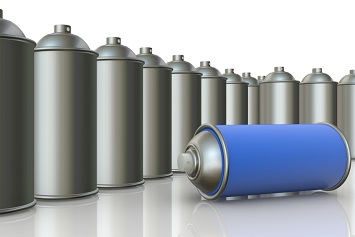On February 7, 2020, hazardous waste aerosol cans will officially enter the national universal waste program. In addition to simplifying compliance with the hazardous waste regulations for handlers of hazardous waste aerosol cans, the EPA believes the rule will result in the diversion of large portions of these cans from landfilling to metal recycling.
EPA regulations at 40 CFR 273.81 list eight factors for determining if a hazardous waste should qualify for the streamlined universal waste requirements. While it is not necessary for a waste to meet all these factors to enter the program, the Agency determined that aerosol cans do satisfy each factor.
As with all new rules, handlers will need to adjust to new requirements; one such requirement addresses the manner in which hazardous waste aerosol cans are to be punctured and drained prior to recycling.
Large and Small Quantity Handlers
The final rule applies to both large and small quantity handlers of hazardous waste aerosol cans. Universal waste handlers are people who generate or produce universal waste as well as people who receive universal waste from other generators or handlers and consolidate it before sending it to another handler; recycler; or treatment, storage, and disposal facility. The universal waste regulations define “large quantity handlers” as those that handle more than 5,000 kilograms (kg) of all universal waste at one time and “small quantity handlers” as those that handle 5,000 kg or less of all universal waste at one time. There are some differences in the regulations that apply to large quantity handlers and small quantity handlers, but the new requirements for puncturing and draining aerosol cans are the same for both categories of handlers.
No Limits on Handlers
In the final rule, the EPA notes that it had considered placing limits on handlers that puncture and drain aerosol cans received from off-site handlers. The concern was that there are so many types of aerosol cans that handlers may not be familiar with how to puncture and drain all cans safely. Based in part on information from the five states with universal waste rules for aerosol cans, the Agency decided that the risks are not sufficient to justify such limits as long as handlers meet risk management measures.
Management Requirements
Under the rule, both large and small quantity handlers that puncture and drain their aerosol cans must recycle the empty punctured cans and meet the following seven requirements:
- Conduct puncturing and draining using a device specifically designed to safely puncture aerosol cans and effectively contain the residual contents and any emissions. The Agency had proposed that handlers puncture and drain aerosol cans only with commercial devices specifically designed to safely perform the action and effectively contain the residual contents, as well as any emissions from puncturing and draining. However, in the preamble of the final rule, the Agency states that the handler must simply ensure that the device is designed or retrofitted according to accepted engineering practices based on established codes, standards, published technical reports, or similar peer-reviewed documents.
- Establish and follow a written procedure detailing how to safely puncture and drain the universal waste aerosol can (including proper assembly, operation and maintenance of the unit, segregation of incompatible wastes, and proper waste management practices to prevent fires or releases); maintain a copy of the manufacturer’s specification and instruction on-site; and ensure employees operating the device are trained in the proper procedures.
- Ensure that puncturing is done in a manner designed to prevent fires and release of any component of universal waste to the environment. This manner includes, but is not limited to, locating the equipment on a solid, flat surface in a well-ventilated area.
- Immediately transfer the contents from the waste aerosol can or puncturing device, if applicable, to a container or tank that meets the applicable requirements of 40 CFR 262.14, 262.15, 262.16, or 262.17. Essentially, this means that universal waste aerosol cans must be accumulated in containers that are structurally sound and compatible with the contents of the aerosol can and that show no evidence of leaks, spills, or damage that could cause leaks under reasonably foreseeable conditions.
- Conduct a hazardous waste determination on the contents of the emptied aerosol can per 40 CFR 262.11. Any hazardous waste generated as a result of puncturing and draining the aerosol can is subject to all applicable requirements of 40 CFR parts 260 through 272. The handler is considered the generator of the hazardous waste and is subject to 40 CFR part 262.
- If the contents are determined to be nonhazardous, the handler may manage the waste in any way that is in compliance with applicable federal, state, or local solid waste regulations.
- A written procedure must be in place in the event of a spill or leak, and a spill cleanup kit must be provided. All spills or leaks of the contents of the aerosol cans must be cleaned up promptly.

